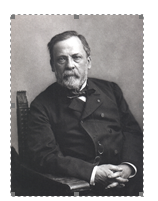https://meditropics.com/louis-pasteur/
*Amaan Ali
*Post-graduate resident, Department Of Medicine, Lady Harding Medical College

Louis Pasteur was born in Dole, Franche-Comtek France, on December 27th, 1822, and he died on September 28th, 1895, at Villeneuve l’Etang, near Paris. Pasteur came from a family of tanners. Louis Pasteur’s father, name was Jean Joseph and mothers name Jeanne Etiennette Roqui. He made brilliant studies not only of the diseases of beer and wine (1866 to 1876) but also of silkworm diseases (1865 to 1869), anthrax (1877 to 1881), gangrene, septicemia, and childbirth fever (1878), rabies (1880 to 1887), fowl cholera (1880), and swine erysipelas (1882). Pasteur may be best known for one of his inventions. It is a process named after him and called as Pasteurization. In 1881 Pasteur develops anthrax vaccine and rabies vaccine in 1885.
A self-sealed hypodermic syringe uses Louis Pasteur’s principle of the “tortuous path” to maintain a sterile condition within a medicament chamber contained within the syringe barrel without using airtight seals.
He is also known as one of the fathers of the germ theory and is one of the founders of Pasteur made the metamorphosis from chemist to microbiologist at the age of 35 because of a decision to focus on amyl alcohol, which he details in the introduction to his 1857 paper on lactic fermentation. Louis Pasteur was the first to recognize that virulence, or the ability of the microbe to cause damage to its host.
In 1860 Pasteur wrote a book entitled “Researches on Molecular Asymmetries” published by THE ALEMBIC CLUB.
STEREOCHEMISTRY (OR SPATIAL CHEMISTRY)- Pasteur made an important contribution to chemistry laying the foundationof stereochemistry through his identification of isomerism in tartaric acid.
CRYSTALLOGRAPHY/MOLECULAR ASYMMETRY-Pasteur demonstrated that a crystal’s shape, its molecular structure and its effect on polarized light are all interrelated. Louis Pasteur studied tartaric acid and noticed that it consisted of two different types of tiny crystals which were mirror images of each other. When polarized light was passed through each, both solutions rotated it, but in opposite directions. When the two crystals were together in equal quantity in a solution, the effect of rotation was cancelled. Thus Louis Pasteur discovered the existence of molecular asymmetry.
FERMENTATION – In the 1850s and 1860s, Louis Pasteur showed that fermentation was a process initiatedby living organisms in a series of investigations.In 1858, Pasteur demonstrated that fermentation was aprocess involving the action of living yeast and that fermentation could also produce lactic acid, which makes wines sour. Through further research, Pasteur showed that the growth of micro-organisms was responsible for spoiling beverages, such as beer, wine and milk.
ANAEROBIOSIS – Pasteur rediscovered anaerobiosis. In 1857, during his study of butyric acid fermentation, Louis Pasteur discovered that the fermentation process could be arrested by passing air through the fermenting fluid. Pasteur thus re-discovered anaerobiosis around 200 years after Leeuwenhoek. His rediscovery led to the establishment of the concept of aerobic and anaerobic life. His process to inhibit the fermentation process through oxygen came to be known as Pasteur Effect.
VACCINES – Louis Pasteur created vaccines for rabies and anthrax. Louis Pasteur’s first important discovery in the study of vaccination came in 1879 and was regarding the disease known as chicken cholera. After accidentally exposing the chickens to an attenuated culture of the disease, he observed that they became resistant to the fully virulent strain. He developed methods of protecting people against two deadly diseases by developing their vaccines, anthrax in 1881 and rabies in 1885.